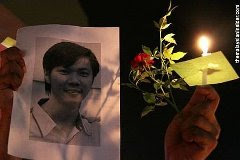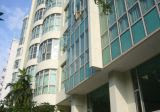Singapore
Price index for non-landed private homes up 2.6%. Latest flash estimates from the National University of Singapore show that its overall price index for non-landed private homes rose 2.6 per cent in May over the preceding month. Since the end of last year, the index has appreciated 8.6 per cent. The Singapore Residential Price Index (SRPI), compiled by the NUS Institute of Real Estate Studies, covers only completed properties.The sub-index for the central region, which covers a basket of properties in postal districts 1-4 and 9-11, grew 2.5 per cent in May over the preceding month, and 7.9 per cent year to date.The sub-index for non-Central region rose at a slightly faster clip, of 2.6 per cent month-on-month in May and 9.1 per cent year to date.
Developers' sales have slowed since May as Europe's economic crisis affected financial markets, causing home buyers to withdraw to the sidelines, even ahead of the June school holidays and World Cup season. The market is expected to enter a consolidation phase, marked by slower sales as developers try their best to maintain prices and potential buyers hold back their purchases, hoping for price cuts. Joseph Tan, executive director (residential) at the firm, forecasts that home prices are likely to remain firm despite his prediction that developers' new private homes sales will slow to about 2,000 units in Q3 from an estimated 4,000 units in Q2 and 4,380 units in Q1. 'Home prices are likely to stay stable given the positive outlook on the economy and strong boom in manufacturing and exports,' he added.
CBRE estimates that developers sold about 600-700 private homes in June, compared with 1,078 homes in May and 2,207 units in April. The developers are estimated to have sold 8,300 units in the first half of this year. They sold 14,688 new homes for the whole of last year. Despite the stronger increase in the central region, the flash estimate index for May for the location was still 3.7 per cent shy of the pre-financial crisis peak in November 2007. In contrast, for the non-central region, the latest index has already exceeded its respective January 2008 pre-crisis peak by 11.1 per cent. As a result, the overall SRPI flash estimate index for May is 5.5 per cent above its November 2007 high.
The Ministry of Trade and Industry (MTI) is offering 10 industrial plots for sale under the second-half 2010 industrial government land sales programme. The plots, with a total land area of 19.92 ha, comprise three sites on the confirmed list and seven on the reserve list.
Five of the 10 sites are new - a 4.65 ha plot at Yishun Street 23/Yishun Avenue 9 on the confirmed list and plots at Woodlands Avenue 12, Tuas View Square, Kaki Bukit Road 4 and Ang Mo Kio Street 62 on the reserve list. The rest are being rolled over from the H1 2010 reserve list.The government will sell all the plots on leases of 30, 45 or 60 years. Colliers International director (industrial) Tan Boon Leong noted that all three plots on the confirmed list are zoned Business 2 use. 'This will cater to strong demand for such sites as seen in the high number of bids for B2 land parcels last year.'
Singapore is the third most liveable city in the world, going by preliminary findings from a broad-based study commissioned by a think-tank here.The Centre for Liveable Cities (CLC) released initial results from its Global Liveable Cities Index (GLCI) at the World Cities Summit (WCS) yesterday. Of the 64 cities assessed, Geneva emerged tops and Zurich second. Copenhagen and Helsinki tied at fourth.Asia-Pacific cities which made it to the top 20 include Hong Kong (eighth), Melbourne (10th), Osaka (16th) and Tokyo (18th). CLC got the study going in 2008 to assess cities' liveability in five areas: economic vibrancy and competitiveness; environmental friendliness and sustainability; domestic security and stability; quality of life and diversity; and governance and leadership.GLCI is still a piece of work in progress, but CLC and some of the study's co-authors will present it at a WCS session today to gather feedback on its criteria and methodology. 'In terms of looking at liveability from a more holistic and balanced framework, I think there are probably very few, if any, such set of indicators that are around,' CLC director and National Environment Agency CEO Andrew Tan told the press yesterday. Across the five areas which the GLCI looked at, Singapore fared best in domestic security, coming in first. It scored fairly well in terms of governance, quality of life and economic vibrancy. But its showing in eco-friendliness was weakest, at 14th place.
Singapore is the 11th most expensive city in the world for expatriates, one place lower than its 10th position last year, says HR consultancy firm Mercer. But the city moved up a notch to fourth place among cities in Asia-Pacific - which for the first time has three cities in the top 10 list of the dearest places for expats.Tokyo remains the most expensive city in Asia-Pacific, with sister city Osaka second, and Hong Kong third. Singapore and Seoul round out the top five. Part of the reason Asian cities feature more prominently in the worldwide top 10 list is the rise in residential property prices in the region, said Mercer senior researcher Nathalie Constantin-Metral. 'At the end of 2009 and the beginning of 2010, residential property prices in many Asian countries rose as the economic environment began to stabilise and demand for good expat housing increased,' said Ms Constantin-Metral.
Kuala Lumpur, Malaysia
Moves by the Malaysian government to develop state land in and around the centre of Kuala Lumpur are being watched by property players amid concern that huge new projects could lead to an over-supply of office space. The state sites add up to more than 240 ha. And in a bid to trim the budget deficit, there has been talk of developing them to 'unlock value' and create a multiplier effect. One such site is a huge 162 ha plot at Sungei Besi - a 10-minute drive from the city centre - that is now the Royal Malaysian Air Force base. This has been earmarked for mixed development, with an Islamic financial centre at its core, once air force moves out. According to media reports, the federal government investment fund 1Malaysia Development and the Qatar Investment Authority are likely to be master planners for the project. Most property players are confident new supply over the next two years can be comfortably absorbed. But others are less certain, pointing to competition from new offices sprouting up in the greater Klang Valley, in areas such as Bangsar, Mont Kiara, Petaling Jaya and Sentral, among others. Unless the planners get it right, the government's projects could put additional pressure on rents post-2012. Yields would also suffer should foreign investors be slow in making Kuala Lumpur home and setting up shop.
Subscribe to:
Post Comments (Atom)



Once again I find myself reading a extremely well written article here on this site. It's so tough to find articles written this well on other sites. I totally agree with your assessment. Thanks for the article.
ReplyDeleteproducts